-
 Bir Kadının Küçük Başkanı?
Bir Kadının Küçük Başkanı?R2 Cat. 229
Heykel
Yılantaşi, Taş
5th or 4th Millennium BC ()
The head is broken from a figurine; enough of the neck remains to show that the head was turned to the proper r. and upward. There is a triangular crease in the center of the forehead. The eyes are asymmetrical, the r. one oval, the I. longer and sli...
-
 Otlayan geyikler ile friz
Otlayan geyikler ile frizR2 Cat. 230
Heykel
Mermer, Taş
600-550 BC (Lidya)
The square joints at the sides are preserved. The flat moulding is similar to but thinner than that above the relief on Cat. 231 (Fig. 401). In Cat. 230, it runs horizontally below the frieze as a ground line. The relief shows a row of three grazing ...
-
 Süvari frizleri
Süvari frizleriR2 Cat. 231
Heykel
Mermer, Taş
550-450 BC (Geç Lidya (Pers))
The joint on the r. is square, that on the I. is beveled, with a plain vertical band in front indicating the end of the relief. There are two flat moldings along the top and bottom; the space above, below, and between is recessed; and the relief is i...
-
Sakallı Adam Başkanı ile Rölyef
R2 Cat. 232
Heykel
Mermer, Taş
500-480 BC (Geç Lidya (Pers))
The relief, which is probably from a funerary stele, was described by Richter, but renewed examination shows that the face is bearded and the nose big and elongated (cf. the bearded boxer, Richter, Archaic Gravestones, no. 31, fig. 92) The hairdo and...
-
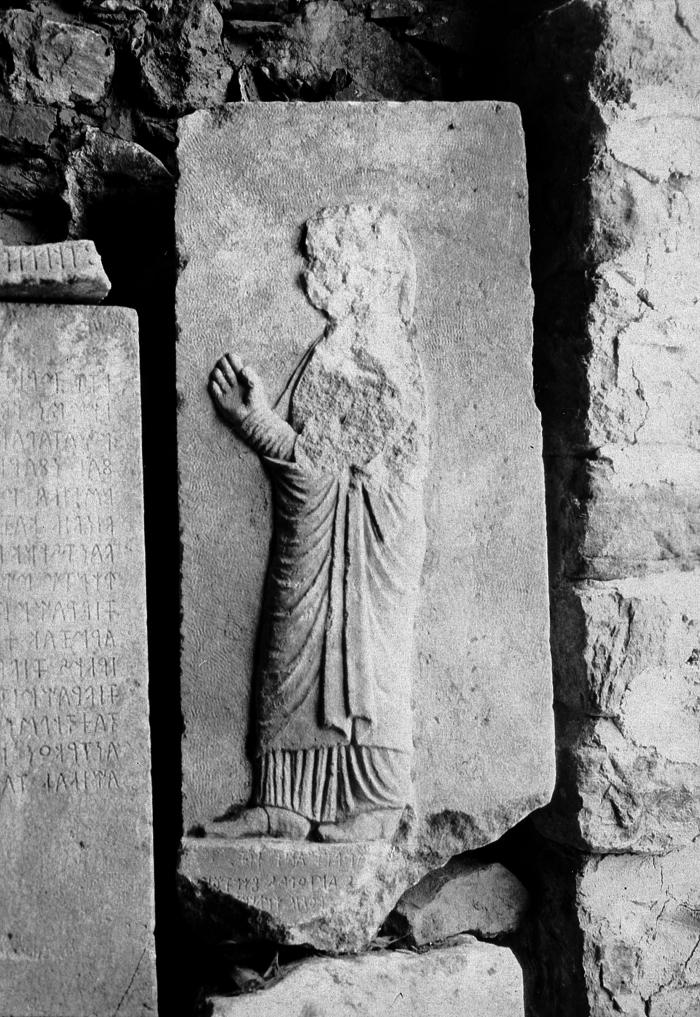 Dua eden kadın ile stel
Dua eden kadın ile stelR2 Cat. 233
Heykel
Mermer, Taş
450-425 BC (Geç Lidya (Pers))
Although there is no sign of dowelling on top, the stele probably had a covering element, possibly a palmette. A female figure facing to I. is placed freely and somewhat asymmetrically on a claw-chiseled background. The sides of the stele are also cl...
-
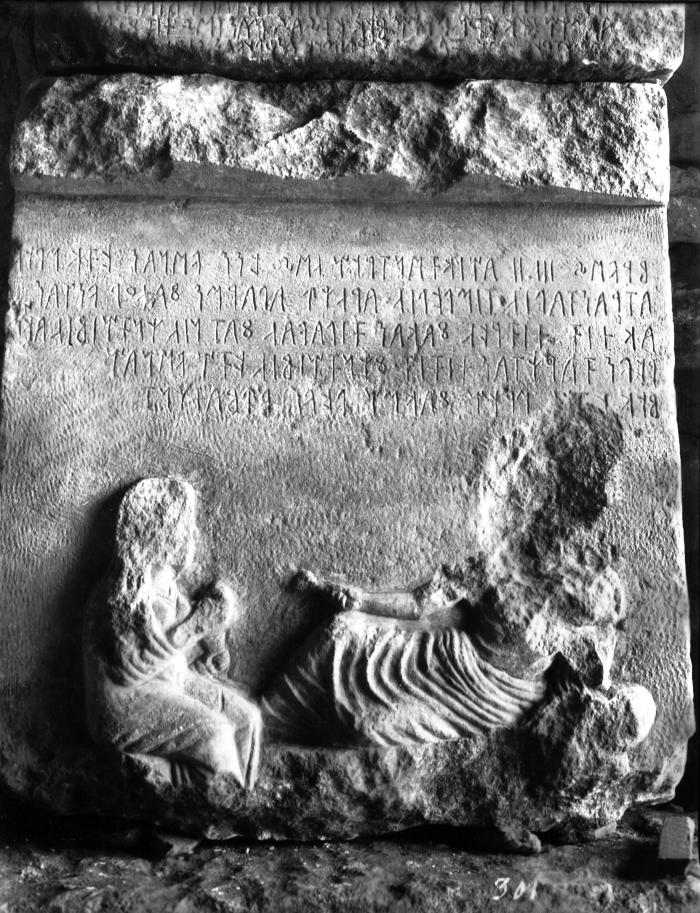 Timles'in oğlu Atrastas'ın Mezar Steli
Timles'in oğlu Atrastas'ın Mezar SteliR2 Cat. 234
Heykel
Mermer, Taş
330-329 BC (Hellenistik)
C. H. Greenewalt, Jr. noted that at the top, the relief molding has painted egg and dart motif, yellow with black background. There are five lines of text in Lydian, with red preserved in some letters. Below the text is a sculptured scene showing a m...
-
 Cenaze Yemeği ile Rölyef
Cenaze Yemeği ile RölyefR2 Cat. 234bis
Heykel
Mermer, Taş
300 BC (Hellenistik)
The bearded man lies on a couch with a drinking cup in his I. hand. A snake coils over his l. shoulder and his veiled wife sits at his feet. Before him stands a three-legged table, beside it a wine jar and a small boy who is serving the wine. On the ...
-
Nannas Anıtından Aslan Sejantı
R2 Cat. 235
Heykel
Mermer, Taş
ca. 500 BC (Geç Lidya (Pers))
The lion is seated in a frontal position. The tail loops under the hindquarters and over the left haunch. The mane has long wavy locks ending slightly down the back, less deeply cut than Synagogue lions (Cat. 25A, Cat. 25B Figs. 92-101). The style is...
-
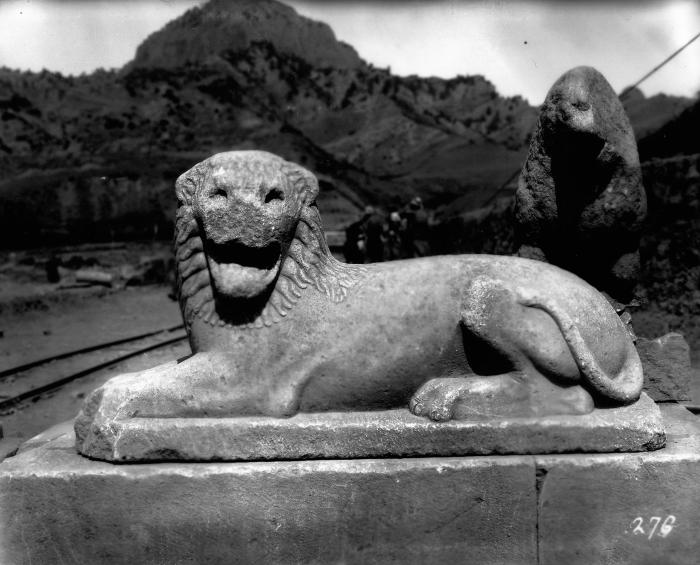 Nannas Anıtından Yaslanan Aslan
Nannas Anıtından Yaslanan AslanR2 Cat. 236
Heykel
Mermer, Taş
550-540 BC (Lidya veya Geç Lidya)
On a plinth with forepaws extended in front, the lion has its head turned to the l. with the mouth wide open and tongue protruding. The eyes are hollow for inlay, the ears fairly close to the head. The mane is arranged in leaf-like locks, many ending...
-
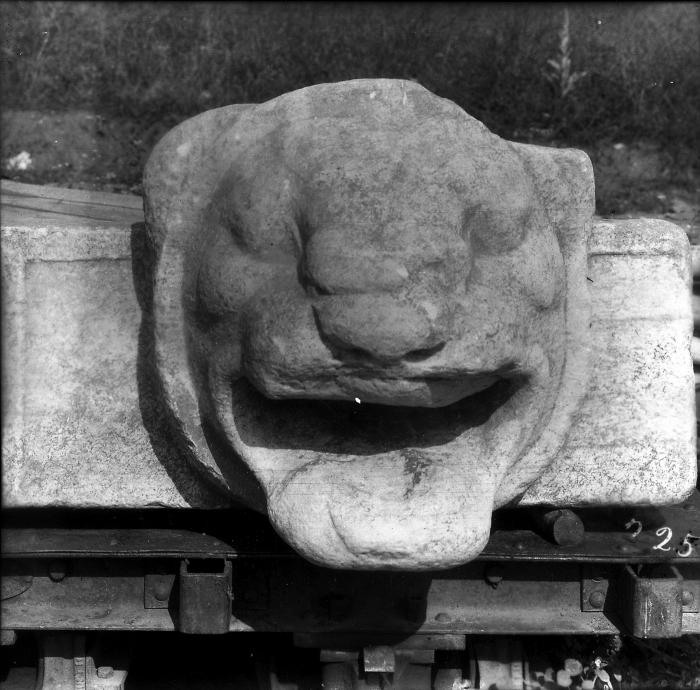 Dikdörtgen üyeye bağlı aslan musluğu
Dikdörtgen üyeye bağlı aslan musluğuR2 Cat. 237
Heykel
Mermer, Taş
()
"This [colossal lion's head] in all probability belonged to the cornice of the temple and when in place, stood in a position almost directly above the spot where it was found, being the water-spout nearest the corner of the temple. The scale of the h...
-
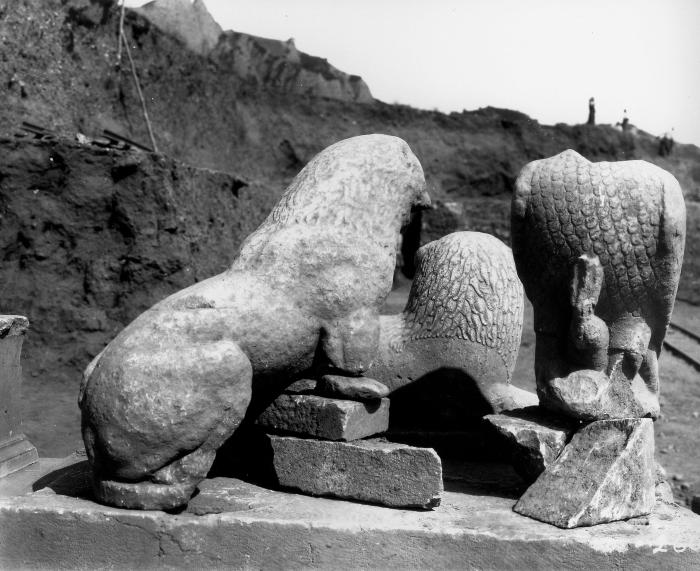 Yırtıcı Kuş (Kartal?) Nannas anıtından bir Tavşan tutarak
Yırtıcı Kuş (Kartal?) Nannas anıtından bir Tavşan tutarakR2 Cat. 238
Heykel
Mermer, Taş
Late archaic? ()
A sitting bird of prey is holding with slightly bent talons a long-eared creature -- hare or rabbit. The wings are folded on the back; they have three tiers of long feathers, while the front part is stylized in small vertical ovals. The chest feather...
-
 Sfenks, muhtemelen bir tahtı veya koltuğu
Sfenks, muhtemelen bir tahtı veya koltuğuR2 Cat. 239
Heykel
Mermer, Taş
480-450 BC (Geç Lidya (Pers))
The seated sphinx is partly in the round, partly in relief. A rectangular slab has been worked so that the forelegs and frontal lower part of the body stand free. Behind the head (now lost) and upper part of the body the background was retained and w...